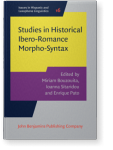Paul O'Neill
List of John Benjamins publications for which Paul O'Neill plays a role.
2018 Near-synonymy in morphological structures: Why Catalans can abolish constitutions but Portuguese and Spanish speakers can’t Extending the notion of near-synonymy: Studies in morphological, syntactic and pragmatic equivalence, Enghels, Renata (ed.), pp. 6–34 | Article
This article examines the concept of defectivity in the verbal system of Spanish, Portuguese and Catalan. Building on previous studies on defective verbs in Spanish and Portuguese I investigate why there are no such defective verbs in Catalan. I conclude that the structure of the verbal paradigm… read more
2018 Chapter 2. Velar allomorphy in Ibero-Romance: Roots, endings and clashes of morphomes Studies in Historical Ibero-Romance Morpho-Syntax, Bouzouita, Miriam, Ioanna Sitaridou and Enrique Pato (eds.), pp. 13–46 | Chapter
This article analyses the historical development of velar allomorphy in the Ibero-Romance verb and argues that the recognition of (i) autonomous morphological structures, or morphomes (Aronoff, 1994), and (ii) variation as to the morphological parsing of velar allomorphy can facilitate more… read more
2014 Similar and differing patterns of allomorphy in the Spanish and Portuguese verbs Portuguese-Spanish Interfaces: Diachrony, synchrony, and contact, Amaral, Patrícia and Ana Maria Carvalho (eds.), pp. 175–202 | Article
This chapter focuses on the different patterns of stem allomorphy in the Spanish and Portuguese verbs and the best way to capture these patterns. It presents synchronic and diachronic evidence along with theoretical arguments to claim that the present tense system of both languages is organized… read more
2009 Imperative morphology in diachrony evidence from the Romance languages Historical Linguistics 2007: Selected papers from the 18th International Conference on Historical Linguistics, Montreal, 6–11 August 2007, Dufresne, Monique, Fernande Dupuis and Etleva Vocaj (eds.), pp. 99–108 | Article
This paper presents an initial comparative-historical synthesis of Romance affirmative imperative morphology. It explores its implications for morphological change generally. Imperatives emerge as a recurrent locus of suppletion and defectiveness, which can uniquely escape morphological changes… read more



